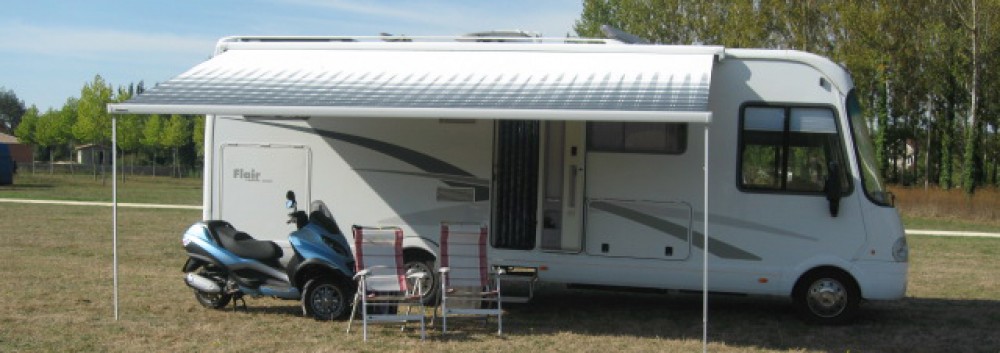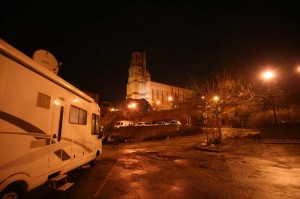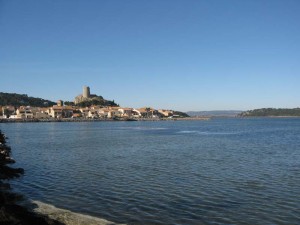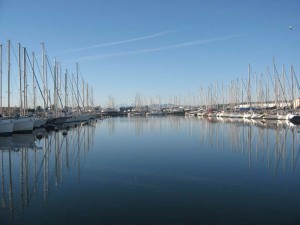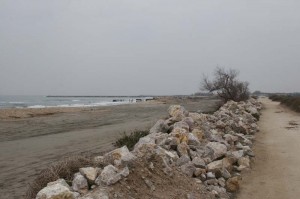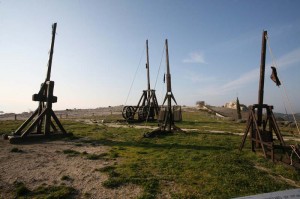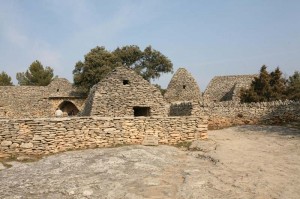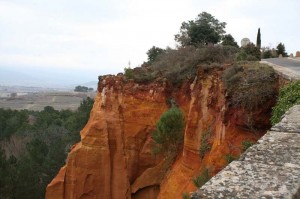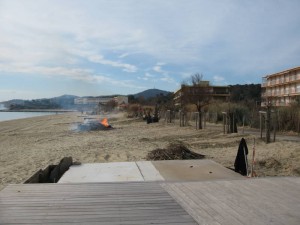We left UK on the 1st of February with snow packed hard on the ground. We were a little reluctant as the previous night our hot water system had frozen when the outside temperature sank to minus 15 centrigrade. The snow had been with us since 19th November and we were fed up of it. I turned off the mains water, not something we usually do as we like to keep the heating on set to the frost setting, but not this time as I dare not leave the water on in case there was a burst pipe once it thawed out. We travelled down to Folkstone, caught the 7pm train and made it down as far as the Aire de la Baie de Somme before parking up for the night.
The next morning we set off with our aim to get south as quickly as possible and hopefully reach warmer weather. We managed around 300 miles ending up at Montlucon. The Aire here is superb even for our 8.5mtr camper. It is surrounded by a 2mtr high fence and has a gated entry, all lit up at night – and its free. Next to the Aire is a small lake and we walked around it before dinner to stretch our legs having been driving all day. There were a couple of bars/cafe’s open on the path around the lake which took around one hour. Montlucon is a good staging post when travelling north or south. Montlucon town centre is around 8kms away and we will take in the town on our next visit.
Albi at night
The next day we headed off to Albi where we were planning on staying for a few days. Albi is different in that they use small red bricks instead of stone for a number of their older buildings. The cathedral is worth visiting and there is a museum just outside. The walk along the river provides a good view of the city in February but a fear the leaves on the trees might block it out in summer – but then maybe shade would be more acceptable. The Aire is inside the main city carpark but is very quiet at night with a great view of the cathedral all lit up at night. Alas the weather wasn’t at its best and we experienced a good deal of fog with drizzle so we moved on after 2 days and headed to the south coast to Gruissan – a firm favorite of ours.
Gruissan Old Town
There are two Aires at Gruissan – one by the marina and one by the beach. The marina one is best in winter and it is only a 20 minute walk or 5 minute cycle ride to the other in any event. The marina itself is semi-open in winter – I mean that as there are approx 50% of the bars/restaurants open. We stayed here for 7 days as the weather was beautiful with clear blue skies and temps in the mid to high teens – prefect. The Aire and marina are about 1 km away from the old town of Gruissan and is a pleasant walk to the market that seems to be open at least 3 days every week with the main one on Monday. There is a castle tower that gives a great view all around for getting your bearings.
Gruissan Marina
The main lake is beside the old town and is a pleasant walk around being approximately 7 to 8 kms. The wildlife is very good with several flocks of flamingo’s, herons etc. We always walk around the lake and this time was no exception, calling at the local cafe on the way back for coffee and pain au chocolate. There is an excellent walk past the marina up to the beach and along to the harbour entrance. Here there is a cafe and oyster farm that will sell you oysters either shucked to eat there or by the dozen to take away. On the opposite side of the marina there is a good promenade walk that goes all around the eastern end of the town and ends up at a carpark on the other side of the harbour entrance.
Park Naturel at Sts Maries de la Mer
From Gruissan we meandered around the coast easterly and stopped at Sts Maries de la Mer. This place is best visited in spring or autumn as it is too hot in summer and too deserted in winter, but it was fine for us. There is a beautiful walk along the coastline towards the centre of the Camargue. It is a “Park Naturel” and protected. You are allowed to visit and again the wildlife are really good. You will see hundreds of pink Flamingoes and the odd herd of wild horses although most are part of the many riding centres dotted around the Camargue. The Aire is becoming pretty run down now and would benefit from a refit but the weather remained excellent so we didn’t complain.
Les Baux
From here we headed north east as we wanted to explore Les Baux. We were not dissappointed – this is a really excellent place to visit. The village is high on a plateau giving excellent views all around the area. The castle and grounds are not to be missed and we were captivated by the commentary given on the walkmans they provided. Entrance cost €6 and is well worth it. During the summer there are live displays of the various weapons, battering rams etc. all preserved and on view. The doll museum is also worth a visit. We learnt that Les Baux was the origins of the Olive with orchards occupying most of the area around Les Baux and sometime in the 1800’s there was a severe winter that killed off over 80% of all the olive trees and the owners decided to move the remainer to Italy for safe keeping.
Fontaine de Vaucluse was our next stop and we decided to use this as a base for touring around the area on Peggy our MP3 scooter. We have visited Fontaine de V several times in the past as it has much to offer. There is the castle on the hill, though not for the faint hearted, there is the source of the fountain – a walk up the river valley to where the water oozes out from under the mountain. There is a lovely walk around the village crossing the Roman aquaduct, built over 2000 years ago and still carries water to this day. The village bustles all year round though does get very busy in summer. From here we visited the villages of Roussillon,Gordes and the Abbey des Senanque. Gordes is another village on top of a hill and can be visited by camper and there is a good Aire for staying overnight in the town centre behind the Gendamerie for those without alternative transport.
Village Bories
At Gordes there is the medieval village Bories that has been restored showing how people lived in the middle ages. Campers park at the first carpark and there is a 1km walk to the village Bories. Roussillon is famous for its red coloured earth and rocks with a walk through the gorge where all the various colours can be seen. We were unlucky during our visit as the entrance is closed between Dec and March but you can get a good view and understanding of how beautiful it is by looking at the other cliffs surrounding Roussillon.
The Red Stones of Roussillon
Finally we visited the Abbey des Senanque. This is one of three Abbeys in the Provence region that has a stone bell tower, whereas all the other Abbeys of the cistercain monks have wooden bell towers. The reason is fire. During the summer it gets so hot that the monks found that the wooden towers easily caught fire so they rebuilt all the ones in Provence of stone.
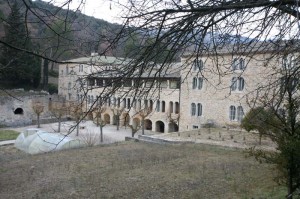 Abbey des Senanque
Abbey des Senanque
By now we had just recieved the news of the birth of our third grand daughter so we moved off to Le Lavandou so that we would be ready to visit her as soon as possible. The morning after we arrived at Le Lavandou there was a knock on the camper door where our daughter-in-law was standing in the rain with our new grand daughter, Felice. We are absolutely thrilled – she is a little angel.
Later that day and all through the night we experienced a really bad storm with gales and driving rain that caused the sea to swell and it ripped away the wonderful boardwalk that runs along the beach from the centre of Le Lavandou to Faviere some 3 kms along the coast.
Le Lavandou afte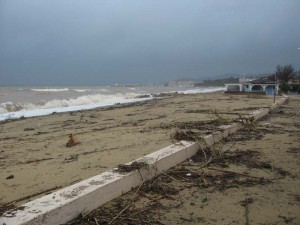 r the Storm
r the Storm
The following morning, walking along the promenade was like walking in a disaster area with uprouted trees, bits of the timber from the walkway and loads of flotsam from the sea. On that day the weather returned to clear blue skies and not a breath of wind. We were amazed to see the local council workers all turn out with their JCB diggers, tractors etc., there must have been over 50 men and women.
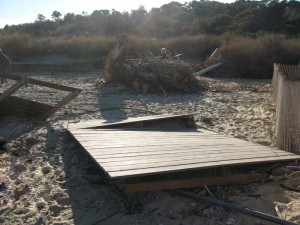 They immediately set to work clearing up the debris, making bonfires and sweeping all the promenade, removing all the sand that had blown onto the road. By late afternoon all the rubbish had been removed, workers were fevourishly working to rebuild the boardwalk and by the end of the week there was not a sign of the damage that had been inflicted on the town – well done the council.
They immediately set to work clearing up the debris, making bonfires and sweeping all the promenade, removing all the sand that had blown onto the road. By late afternoon all the rubbish had been removed, workers were fevourishly working to rebuild the boardwalk and by the end of the week there was not a sign of the damage that had been inflicted on the town – well done the council.
We had come to Le Lavandou for the specific purpose of attending the Borme les Mimosa flower festival. We had been here many times in the past but had missed the festival each time. This time we were here at the right time and we were not dissappointed. We had the added bonus of having the company of our new grand daughter – only 4 days old.
Borme Les Mimosa Festival
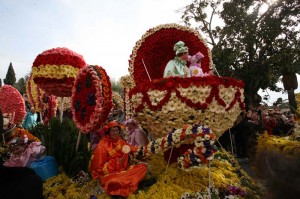 Another regular stopping place for us is the private Aire at St Tropez. We started visiting here some 5 years ago when it was a small walled area catering for a maximum of around 15 campers. The owner had a small covered BBQ area that doubled up as a bar, selling his wine (anything you like so long as it was rose) and his claim to fame that he mentioned to every customer that his wine was preferred by Brigite Bardo no less. Over the years it has expanded, the BBQ demolished to fit in more campers, the vines chopped down to fit in even more campers. Even the next door neighbours garden has been requisitioned as more camper spaces. It can now accomodate around 100 campers but sadly on the same facilities. Still it is a great place to stay when visiting St Tropez and at €11 per night the best value around (even the coffee costs €5 per cup in St T) The location is some 5kms out of the centre and there is one of the most beautiful coastal walks into town around the headland on the south coast. The path takes you past many of the celebrity villas, including Brigite Bardo, where they have built their own tiled beach areas, mini harbours and personal paths down to the waters edge. There is another walk from the Aire to the Tamaris beach and around the headland back towards St Tropez – this time a 3 hour walk of around 12kms. St Tropez is St Tropez and bustles all year round, particularly around the harbour area where there are expensive yachts, street artists and more Rolls Royce and Ferraris than you can shake a stick at.
Another regular stopping place for us is the private Aire at St Tropez. We started visiting here some 5 years ago when it was a small walled area catering for a maximum of around 15 campers. The owner had a small covered BBQ area that doubled up as a bar, selling his wine (anything you like so long as it was rose) and his claim to fame that he mentioned to every customer that his wine was preferred by Brigite Bardo no less. Over the years it has expanded, the BBQ demolished to fit in more campers, the vines chopped down to fit in even more campers. Even the next door neighbours garden has been requisitioned as more camper spaces. It can now accomodate around 100 campers but sadly on the same facilities. Still it is a great place to stay when visiting St Tropez and at €11 per night the best value around (even the coffee costs €5 per cup in St T) The location is some 5kms out of the centre and there is one of the most beautiful coastal walks into town around the headland on the south coast. The path takes you past many of the celebrity villas, including Brigite Bardo, where they have built their own tiled beach areas, mini harbours and personal paths down to the waters edge. There is another walk from the Aire to the Tamaris beach and around the headland back towards St Tropez – this time a 3 hour walk of around 12kms. St Tropez is St Tropez and bustles all year round, particularly around the harbour area where there are expensive yachts, street artists and more Rolls Royce and Ferraris than you can shake a stick at.
Felice at 4 days old
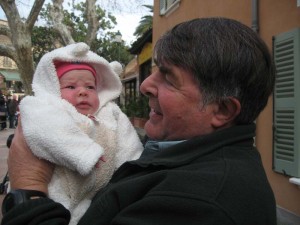 We naturally spent many hours visiting our family and we had our eldest grand daughter, Greta to stay with us in the camper for a few days. We moved from St Tropez to Le Luc and stayed on the Les Bruyers “open all year” site between Le Luc and Les Mayons. Although technically open from the charges per night point there were no toilet or shower blocks open and the water was all turned off – even the WC emptying point water was off. Not a place to be recommended. We stayed for a few days then moved over to Les Arc to the private Aire in the grounds of the local wine producers, using Peggy to ferry us from the Aire to our family. Sadly all good things come to an end and we were soon on our way back north to Calais, breaking the journey only once at St Poncin sur Sioule – a great Aire on the banks of the Sioule that would make many campsites look poor with its neat individual plots, flower tubs, EHU points and state of the art service facility. There are even tennis courts next door. From St Poncin to Calais is a good days drive in our camper van but we arrived in good time to refuel, restock and catch the train for home.
We naturally spent many hours visiting our family and we had our eldest grand daughter, Greta to stay with us in the camper for a few days. We moved from St Tropez to Le Luc and stayed on the Les Bruyers “open all year” site between Le Luc and Les Mayons. Although technically open from the charges per night point there were no toilet or shower blocks open and the water was all turned off – even the WC emptying point water was off. Not a place to be recommended. We stayed for a few days then moved over to Les Arc to the private Aire in the grounds of the local wine producers, using Peggy to ferry us from the Aire to our family. Sadly all good things come to an end and we were soon on our way back north to Calais, breaking the journey only once at St Poncin sur Sioule – a great Aire on the banks of the Sioule that would make many campsites look poor with its neat individual plots, flower tubs, EHU points and state of the art service facility. There are even tennis courts next door. From St Poncin to Calais is a good days drive in our camper van but we arrived in good time to refuel, restock and catch the train for home.
Trip Statistics:
Time away: 42 days Distance Travelled 2823 miles
Cost of ferry: Tesco Cost of fuel: £636.37
Cost of LPG: £49.20 Cost of Tolls: £70.91
Cost of campsites £139.66 Fuel cost for Peggy £26.40
Exchange rate: £1 = €1.09
